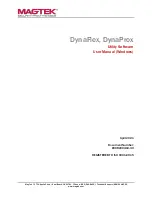
System Features
8 - 7
CopyFiles
Windows CE expects certain files to be in the Windows folder, residing in volatile storage. Windows CE
maintains the System Registry in volatile storage. CopyFiles copies files from one folder to another on a cold
boot. Files can be copied from a non-volatile partition (Application or Platform) to the Windows or other volatile
partition during a cold boot. During a cold boot CopyFiles looks for files with a .CPY extension in the root of the
Platform, then Application FFS partition. These files are text files containing the source and destination for the
desired files to be copied separated by ">". Following is the content of a sample .cpy file that copies
ScanSamp2.exe from the
Applications\Samples
folder to the
\Windows
folder.
Example:
Content of ScanSamp2.cpy
\Application\ Samples\ScanSamp2.exe > \Windows\ScanSamp2.exe
Files are copied to the Windows folder from the flash file system using copy files (*.cpy) in the following order:
\Platform
\Application
Accessing the Windows
®
CE Desktop
If an MK2200 is configured to launch an application on power-up, you can bypass the application at boot-up to
access to the Windows
®
CE desktop. See
Accessing the Windows® CE Desktop on page 6-2
.
Password Protection (Gate Keeper)
The Gate Keeper application provides password protection preventing unauthorized access to the Windows
®
CE desktop.
•
At bootup
: After Windows
®
CE boots (just after the blue
Performing System Initialization (Phase 1)
screen
displays), but before an application launches, the Gate Keeper application checks (for two seconds) to
see if the user selected the appropriate combination of buttons (currently
A
and
D
) to request password
entry. See
Accessing the Windows® CE Desktop on page 6-2
•
While an application is running
: Gate Keeper also password protects access to button functionality
such as viewing the System menu while an application is running. See
and
for a list of button functionality.
The buttons are mapped to produce the characters 1, 2, 3, 4, Enter, and Escape, as listed in
. On the
password screen, enter the desired character sequence and press
Enter
to submit the password and gain
access to the Windows
®
desktop. If the password is incorrect, the MK2200 runs the specified user
applications.
NOTE
When specifying the protected mode password in the RDM or System Menu, enter the
password in terms of the characters mapped by Gate Keeper (1-4), not the alphabetic labels (A-D)
used in this document.
The default password is 4,4,2,1,3.
Summary of Contents for MK2200 MicroKiosk
Page 1: ...MK2200 MicroKiosk for CE NET 4 2 Product Reference Guide...
Page 2: ......
Page 3: ...MK2200 MicroKiosk for CE NET 4 2 Product Reference Guide 72E 87925 01 Revision A August 2006...
Page 16: ...xiv MK2200 MicroKiosk for CE NET 4 2 Product Reference Guide...
Page 82: ...3 32 MK2200 MicroKiosk for CE NET 4 2 Product Reference Guide...
Page 112: ...4 30 MK2200 MicroKiosk for CE NET 4 2 Product Reference Guide...
Page 116: ...5 4 MK2200 MicroKiosk for CE NET 4 2 Product Reference Guide...
Page 142: ...6 26 MK2200 MicroKiosk for CE NET 4 2 Product Reference Guide...
Page 156: ...7 14 MK2200 MicroKiosk for CE NET 4 2 Product Reference Guide...
Page 182: ...8 26 MK2200 MicroKiosk for CE NET 4 2 Product Reference Guide...
Page 186: ...9 4 MK2200 MicroKiosk for CE NET 4 2 Product Reference Guide...
Page 188: ...A 2 MK2200 MicroKiosk for CE NET 4 2 Product Reference Guide...
Page 217: ...Appendix D Web Kiosk Software Suite Bar Codes D 5 Rolaids CD 3 12546 65021 3 0 75678 12772 4...
Page 224: ...E 4 MK2200 MicroKiosk for CE NET 4 2 Product Reference Guide...
Page 246: ...G 12 MK2200 MicroKiosk for CE NET 4 2 Product Reference Guide...
Page 274: ...Index 8 MK2200 MicroKiosk for CE NET 4 2 Product Reference Guide...
Page 276: ......
Page 277: ......
















































